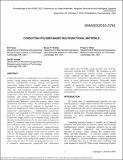Conducting Polymer-Based Multifunctional Materials
Author(s)
Paster, Eli Travis; Ruddy, Bryan P; Pillai, Priam Vasudevan; Hunter, Ian
Download105_1.pdf (1.128Mb)
PUBLISHER_POLICY
Publisher Policy
Article is made available in accordance with the publisher's policy and may be subject to US copyright law. Please refer to the publisher's site for terms of use.
Terms of use
Metadata
Show full item recordAbstract
Conducting polymers are employable as low-voltage actuators, sensors, energy storage and delivery components, structural elements, computational circuitry, memory, and electronic components, making them a versatile choice for creating integrated, multifunctional materials and devices. Here we show one such conducting polymer-based, multifunctional system, derived from the versatility of the conducting polymer polypyrrole. Three functions of polypyrrole (actuation, length sensation, and energy storage) have been individually evaluated and cooperatively combined in the synthesis of a multifunctional, polymeric system that actuates, senses strain deformation, and stores energy. The system operates whereby the strain of a polypyrrole actuator is measured by a polypyrrole length sensor, whilst being powered by an array of polypyrrole supercapacitors. Independently, polypyrrole actuators were evaluated at 250 discrete frequencies ranging from 0.01 to 10 Hz using fixed, ±1 V sinusoidal excitation. Polypyrrole length sensors were evaluated using a thin-film dynamic mechanical analyzer for the same range of frequencies with a 2% sinusoidal input strain. Polypyrrole supercapacitors were evaluated using cyclic voltammetry (-1.0 V to +1.0 V; 12.5 to 100 mV/sec) and galvanostatic charge-discharge cycling (0.5 to 2 mA/mg). As an actuator, polypyrrole samples showed measureable actuation strain between 0.001% and 1.6% for the frequency range tested, with amplitude versus frequency decay behavior similar to a first-order low-pass filter. As a length sensor, polypyrrole samples showed linear-elastic behavior up to 3% strain and gauge factors near 4. As a symmetric supercapacitor, polypyrrole had capacitance values higher than 20 kF/kg, energy densities near 20 kJ/kg, and power densities near 2 kW/kg. The evaluation of each component, independently, justified creating a cooperative system composed of these three components operating simultaneously. Polypyrrole supercapacitors provided ample power to excite polypyrrole actuators. Polypyrrole length sensors attached in series to polypyrrole actuators were capable of measuring strain from coupled polypyrrole actuators. Performance metrics and future possibilities regarding conducting polymer-based multifunctional materials are discussed. Topics: Polymers , Multifunctional materials
Date issued
2010-09Department
Massachusetts Institute of Technology. Department of Mechanical EngineeringJournal
ASME 2010 Conference on Smart Materials, Adaptive Structures and Intelligent Systems, Volume 2
Publisher
ASME International
Citation
Paster, Eli, Bryan P. Ruddy, Priam V. Pillai, and Ian W. Hunter. “Conducting Polymer-Based Multifunctional Materials.” Proceedings of the ASME 2010 Conference on Smart Materials, Adaptive Structures and Intelligent Systems, 28 September - 1 October, 2010, Philadelphia, Pennsylvania, ASME, 2010. © 2010 ASME
Version: Final published version
ISBN
978-0-7918-4416-8